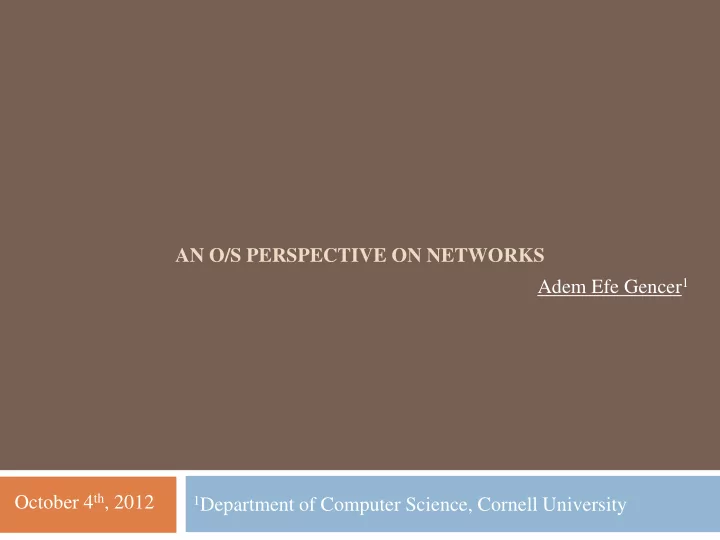

AN O/S PERSPECTIVE ON NETWORKS Adem Efe Gencer 1 October 4 th , 2012 1 Department of Computer Science, Cornell University
Papers 2 Active Messages: A Mechanism for Integrated Communication and Control, Thorsten von Eicken, David E. Culler, Seth Copen Goldstein, and Klaus Erik Schauser. In Proceedings of the 19th Annual International Symposium on Computer Architecture, 1992. U-Net: A User-Level Network Interface for Parallel and Distributed Computing, Thorsten von Eicken, Anindya Basu, Vineet Buch and Werner Vogels. 15th SOSP, December 1995.
Authors - I 3 Thorsten von Eicken Founder of RightScale Ph.D, CS at University of California, Berkeley Assistant Prof. at Cornell (1993-1999) David E. Culler Chair, Electrical Engineering and Computer Sciences at Berkeley Seth Copen Goldstein Associate Professor at Carnegie Mellon University Klaus Erik Schauser Associate professor at UCSB
Authors - II 4 Thorsten von Eicken Anindya Basu Advised by von Eicken Vineet Buch Google MS from Cornell Werner Vogels Research Scientist at Cornell (1994-2004) CTO and vice President of Amazon
Active Messages 5 Introduction Preview: Active Message Traditional programming models Active Messages Environment Split-C Message Driven Model vs. Active Messages Final Notes
Introduction 6 Inefficient use of underlying hardware Poor overlap between communication and computation High communication overhead Communication Computation
Introduction: Objective 7 Eliminate inefficiency by increasing the overlap between communication & computation !
Preview: Active Message 8 Solution: A novel asynchronous communication mechanism! Active messages MESSAGE ? ACTIVE MESSAGE HEADER BODY Argument of Address of a userspace handler userspace handler
Traditional Programming Models 9 Synchronous comm. 3-phase protocol Send / receive are blocking Simple No buffering High comm. latency Underutilized network bandwidth
Traditional Programming Models 10 Asynchronous comm. Send / receive are non-blocking Message layer buffers the message Communication & Computation can overlap
Traditional Programming Models 11 Synchronous Asynchronous PROS No Buffering Overlap Active Messages CONS No Overlap Buffering High Comm. Latency
Active Messages 12 Requires SPMD programming model Key optimization: not buffered Except for network transport buffering For large messages buffering is needed on sender side Receiving side pre-allocates structures Handlers do not block - deadlock avoidance
Active Messages 13 Sender Packs the message with a header containing handler’s address Pass the message to the network Continue computing Receiver Message arrival invokes handler Handler Extracts the data & interrupts computation Passes it to the ongoing computation Implementation of active messages on different platforms is not the same (nCube/2 vs. CM-5).
Environment 14 Implementation on parallel supercomputers nCUBE/2 Binary hypercube network NI with 28 DMA channels CM-5 (connection machine-5) Hypertree network Split-C A parallel extension of C CM-5 machine of NSA
Split-C: PUT and GET 15 Nonblocking Used in matrix multiplication to show the performance of active Message handler message Message formatter
Split-C: GET 16 Matrix multiply achieves 95% performance in nCUBE/2 configuration. Xmit: time to inject the message info the network Hops: time for the network hops
Split-C: Matrix Multiply 17 • m : # of columns per processor • # of nodes is constant (N=128)
Message Driven Model vs. Active Messages 18 Message driven model Computation in message handlers Handler may suspend Memory allocation & scheduling on message arrival Active Messages Computation in background (handler extracts message) Immediate execution
Final Notes 19 Not a new parallel programming paradigm! A primitive communication mechanism Used to implement them efficiently The need for userspace handler address leads to programming difficulty Requires SPMD model (but not required on some modified versions)
U-Net 20 Introduction U-Net Remove the Kernel from Critical Path Communication in U-Net Protection Zero Copy True zero copy vs. zero copy Environment Performance Final Notes
Introduction 21 Low bandwidth and high communication latency No longer hardware issues! Problem is the message path through the kernel Small messages Common in various applications Requires low round-trip latency Latency = processing overhead + network latency
Introduction: Objective 22 Make communication FASTER !
U-Net 23 Low communication latency High bandwidth even with small messages! Support for workstations with off-the shelf network Keep providing full protection Kernel controlled channel setup / tear-down TCP, UDP, Active Messages, … can be implemented
Remove the kernel from critical path 24 Solution: Enable user-level access to NI to implement user-level communication protocols Does not require OS modification or custom HW Provides higher flexibility (app. specific protocols!)
Communication in U-Net 25 Each process creates endpoints to access network U-net endpoint: application handle into the network Communication segment : regions of memory that hold message data Send/recv/free queues : hold message descriptors
Communication in U-Net: Send 26
Communication in U-Net: Receive 27
Protection 28 Owning process protection: Endpoints Accessible by owning Communication Segments process only! Send/Receive/Free Queues Tag protection: Outgoing message tagged with originating address Incoming message delivered to correct destination point only!
Zero Copy 29 Base level U-Net (zero copy) Send/receive needs a buffer (not really “zero” copy!) Requires a copy between app. data structures and a buffer in the comm. segment Direct Access U-Net (true zero copy) Spans on entire address space Has special hardware requirements
Environment 30 Implementation on off-the-shelf hardware platform SPARCStations Fore SBA-100 NIC Fore SBA-200 NIC SunOS 4.1.3 Fore SBA-200 NIC BSD-based Unix OS Ancestor of Solaris (after version 5.0) Split-C A parallel extension of C
Performance: UDP vs. TCP 31 UDP bandwidth as a TCP bandwidth as a function of function of message size data generation by application
Performance: UDP vs. TCP 32 Fast U-Net roundtrips : Apprx. 7x speedup for TCP Apprx. 5x speedup for UDP Fast U-Net TCP roundtrips let use of small window size. End-to-end round-trip latencies as a function of message size
Final Notes 33 Low comm. latency High bandwidth Good flexibility Cluster of workstations vs. supercomputers Comparable performance using U-Net Additional system resources (parallel process scheduler, file systems, …) are needed
Recommend
More recommend